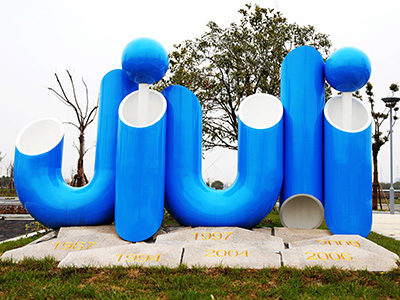In 2018, China's stainless steel industry has been steadily improving, with improved operation quality, efficient production operation, and effective play of high-quality capacity. The annual capacity utilization rate is close to 80%, and the profitability is enhanced, and the benefit is obviously improved. While deleveraging and optimizing the debt structure, enterprises have strengthened technological equipment and technological innovation, optimized the product structure and improved the quality.
I. Analysis of the current situation of the industry operation
(a) stainless steel production situation
In 2018, the growth of stainless steel steelmaking capacity was limited, with an increase of 900,000 tons from Fujian Qingtu and 1 million tons from Indonesia Qingshan, but the growth of stainless steel cold rolling capacity and output was advancing by leaps and leaps. In 2017 with 1.7 million tons of cold rolled stainless steel production capacity reaches producing in 2018, in 2018 and 3 million tons of cold rolled stainless steel on stream production capacity, make the domestic market of stainless steel hot rolling hot and cold rolled resources abundant become the norm, hot and cold rolling gap also from 800 ~ 1200 yuan/ton shrunk to the current 400 ~ 800 yuan/ton, hot and cold rolling same price and even visited the inversion phenomenon is also increasingly frequent.
In 2018, the output of stainless steel crude steel was 26.706,800 tons, an increase of 9333,100 tons year-on-year, an increase of 3.62%. Among them: Cr-Ni steel (300 series) 12.820,700 tons, an increase of 100,000 tons, an increase of 0.78%, accounting for 48.01%, a decrease of 1.35 percentage points; CR steel (400 series) 5.4670 million tons, an increase of 399,000 tons, an increase of 7.30%, the share of 20.47%, an increase of 0.81 percentage points; Cr-Mn steel (200 series, including some products that do not meet the national standard) 8,258,500 tons, an increase of 375,300 tons year-on-year, an increase of 4.54%, accounting for 30.92%, an increase of 0.34 percentage points year-on-year. 2018 steel structure change is due to the import of a large number of 300 series stainless steel. With the large-scale equipment and enterprises pay more attention to quality, the quality of stainless steel products improved steadily.

In 2018, the output of dual-phase stainless steel in China achieved another good performance, reaching 160,660 tons, up 36.54% year on year. It accounts for 0.6% of the total.

Ⅱ stainless steel demand analysis
In 2018, China's stainless steel consumption is better than expected, demand further growth. 2018 fill board increase infrastructure investment in China, the implementation of the beautiful China, beautiful country, consumer upgrades, energy structure adjustment and industrial equipment and policy initiatives such as "One Belt And One Road" strongly promote stainless steel consumption growth, make up for trade friction caused by factors such as stainless steel products and stainless steel products export is blocked. In 2018, the apparent consumption of stainless steel in the country was 21.32336 million tons, an increase of 1.3963 million tons year-on-year, an increase of 7.01%. The growth rate dropped 0.23 percentage points compared with 2017, and the consumption growth rate was 3.39 percentage points higher than the output growth rate.
ⅢMarket spot inventory analysis
2018 stainless steel destocking effect is obvious. In 2018, the total inventory in Wuxi and Foshan maintained between 300,000 to 400,000 tons (except around the Spring Festival), reaching the peak of the year in the second and fourth quarters. The inventory of 200 series has increased from 14% at the beginning of the year to around 22% at present. The inventory of 300 series decreased slightly before the comparison, from 70% at the beginning of the year to about 63% at present, while the inventory of 400 series changed little. In general, stainless steel prices and market inventory changes maintain a positive logical relationship, when the inventory is reduced to a certain amount of steel prices will rebound; Similarly, when the price continues to decline for a long time, traders in the market will be weakened to prepare goods, and the market inventory is reduced in stages, and finally the stock is overstocked.

Ⅳ stainless steel import and export analysis
In 2018, stainless steel industry exports continued to grow and imports increased significantly. The export structure was improved, and the proportion of high-end export products increased significantly. In 2018, 1,852,900 tons of stainless steel were imported, an increase of 647,800 tons year-on-year, an increase of 53.76%; The export of stainless steel was 3,994,500 tons, an increase of 52,700 tons year-on-year, an increase of 1.34%.
Sino-us trade friction causes the United States to impose extra 25% of China's steel tariffs, which involves more than stainless steel products tariff lines, specific products ranging from primary products, stainless steel pipe, bar wire and stainless steel plate (with), stainless steel plate (with) of concentrated in the hot rolled stainless steel coil, plate, cold rolled part mainly concentrated in the narrow band. In July 2016, the US Department of Commerce made a preliminary ruling on the subsidy investigation of stainless steel sheet and strip from China, which had already reduced the amount of stainless steel sheet and strip exported from China to the US. In the first quarter of 2018, the total volume of China's stainless steel exports to the United States is only about 0.55 million tons/month, which means that the total volume of China's stainless steel exports to the United States is about 70 million tons/year. Compared with China's 4 million tons of stainless steel exports, the volume proportion is very small, and the direct impact of Sino-US trade friction on China's stainless steel is very small. Sino-US trade friction should be the biggest impact of stainless steel downstream industry demand has been depressed, from the current automotive, home appliances, products and other industries stainless steel demand decline has been serious can feel its influence.
(Ⅴ) stainless steel price trend
In 2018, environmental inspection, Dainan medium frequency furnace shut down, Sino-US trade friction, stainless steel anti-dumping in Indonesia and other places and other events have appeared, also caused a greater impact on the stainless steel market, but in the domestic major enterprises under the maintenance of 2018 price overall stability. Compared with the previous two years, the overall operation of stainless steel prices in 2018 is stable, especially in the first quarter and the third quarter of the shock range is not more than 1000 yuan/ton, and the second quarter has a significant rise and then fall trend, the rise is due to the effective destocking of the market, the bottom of production profits, strict environmental supervision and effective production reduction of steel mills; However, in the fourth quarter, under the pressure of weakening demand, trade friction and export obstruction, the price gradually fell, and the price of 304 cold and hot rolling basically reached the lowest point of the year. Supply level, the domestic production of stainless steel to maintain a stable small growth, and Indonesia's increase on the domestic market impact is greater, in addition to the direct impact of stainless steel reflux domestic, also has an indirect impact on China's exports; In 2019, Indonesia's production capacity continues to increase, the domestic increase can not be ignored, only the supply side pressure is not small, and the macroeconomic and terminal demand challenges continue to exist, so the stainless steel market in 2019 May need to find a new way out.

Ⅵstainless steel industry benefits
With the country's supply-side structural reform continues to force, 2018, China's stainless steel prices overall stable and better, raw material price fluctuations narrowed. Companies have seized the favorable opportunity to effectively release efficient hot and cold rolling capacity, reducing costs and improving efficiency, and turning some long-term loss-making enterprises into profits.
In the stainless steel industry seven key listed companies as a sample, according to the 2018 annual report statistics show that the stainless steel industry in 2018 a total of annual revenue of 577.716 billion yuan, a year-on-year growth of 8.86%; Net profit attributable to the parent company was 38.379 billion yuan, up 22.24% year on year.

In 2018, among the seven key listed companies in the stainless steel industry, only one company, Xinxing Casting Tube, saw its operating income decline, down 1.99% year-on-year. From the point of net profit, the net profit of the seven listed companies in the stainless steel industry kept growing, among which, the net profit of JISG Hongxing and Jiuli Special Material grew faster, reaching more than 100%.

Second, the development trend of stainless steel industry
In 2018, the overall operation of China's stainless steel industry is stable and good. Although the possibility of China's economic adjustment in 2019 has been improved, but due to the functionality of stainless steel, irreplaceable and other characteristics, China's stainless steel production and marketing is still expected to show a steady rise.
(a) stainless steel supply and demand are expected to grow
On the supply side, stainless steel production capacity continues to grow in 2019, stainless steel production capacity expansion is rapid, but output still needs time; The import window will be bigger and bigger, but the export will continue to be subjected to certain resistance and extrusion; Steel mill inventory and social inventory are high.
Demand, stainless steel supply increases at the same time, apparent consumption is also growing steadily; The demand of downstream industries such as home appliances and automobiles grew steadily. There is still great potential in the field of civil use and general carbon steel alternatives.
The stainless steel industry is also under pressure from different aspects. Whether it is domestic, Indonesia's continuous expansion of production capacity, or the domestic property economy is not ideal, the impact of the home appliances market and the national economy, or the continued tight monetary policy, for the stainless steel industry, are inevitable challenges.
(b)We will upgrade to ultra-low emissions and upgrade green development
In the future, the stainless steel industry will continue to maintain green and high-quality development. On the one hand, on the basis of doing a good job of air and water pollution treatment to meet the national emission standards, more attention should be paid to the treatment of waste residue and waste acid. On the other hand, at present or for a period of time in the future, further increase investment in research and development, increase governance efforts, strive to achieve waste residue recycling, waste acid reduction and recycling, and effectively promote the green manufacturing of stainless steel industry.
(c) Accelerated import substitution with the improvement of industry technology and the upgrading of product structure
Although the development of China's stainless steel industry is short, but the technical progress is fast, the equipment level of the leading enterprises in the stainless steel industry in China has reached the international advanced level, but there is still a gap with foreign advanced enterprises in some high-end products. According to the data of relevant departments, in recent years, China's stainless steel imports have been rising year by year, from hundreds of thousands of tons to about 2 million tons; And single tons of steel prices far higher than the export price of per ton steel imports, imports mainly for high-end stainless steel, the influence of national industrial policy and science and technology level, industry research and development and the investment of equipment is a rapid growth, the next sector is expected to further improve the technical level, finally realizes the import substitution, related businesses will therefore suffer


















